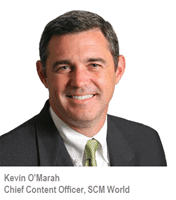
Part 1: Finding a Balance — Cadence and Event Driven S&OP
Karin: Based on your discussions with leading organizations and SCM World’s research, how important do you find sales and operations planning (S&OP) in driving consensus and value for global operations?
Kevin: S&OP is unbelievably important. In fact, we say around here that S&OP is at the center of the universe. When you speak with companies, it is clear that everything comes back to S&OP. For example, many conversations I have with supply chain leaders start on one topic — operational excellence, demand planning, etc. — yet they always end up back on sales and operations planning.
Sales and operations planning is the single most important initiative driving consensus for global operations and, where value is created. S&OP is where the customer and broader market demand come together with the ability for the company to profitably satisfy demand. As such, it is the place where you go from theoretical idea of supply chain value to the actual delivery of supply chain value. Order by order, customer by customer, where does value get created and how does the customer perceive that value?
Sales and operations planning is the starting point for the discussion on how to balance these tradeoffs? Customers want what they want immediately and for free. While this is not possible to fulfill, we as supply chain leaders must determine how we give customers what they care about the most. Will they accept a premium to have it immediately? Will they take it delivered unassembled and 2 weeks from now if they get a discount? S&OP is the place where these tradeoffs get figured out.
Karin: In the 2014 Chief Supply Chain Officer Report you noted Customer Demand Volatility is the top overall concern of supply chain executives. What impact does increased Demand Volatility have on the S&OP process?

Customer demand volatility is stressing the S&OP process by forcing organizations to accelerate their decision-making capabilities beyond what they are currently able to cope with. It’s a big problem and in fact I think it is forcing an evolution in S&OP from this relatively rhythmic process to something that is a lot more dynamic and event driven.
Karin: Are you finding that top performing companies are conducting a weekly S&OP meeting?
Kevin: Sales and Operations Planning meetings that are weekly are probably the norm, but they tend to support a monthly or quarterly planning process. Often we find these less frequent meetings are rolled up to their Integrated Business Planning (IBP) initiative.
However, weekly meetings are not always enough nor are they really the only venue for final resolution. We are finding that people need S&OP type problem solving sessions more frequently. I don’t think they can afford to wait for the weekly meetings anymore. They need more opportunities to balance supply and demand.
The change is that cadence is gradually being swapped out for something that enables a more rapid pace and this is being driven by a Control Tower philosophy. These Control Tower meetings can be accomplished in an hour, or more as needed, and address either an opportunity or challenge that needs to be resolved quickly.
This is also highly complementary of a cadence-driven S&OP process. They are not mutually exclusive.
Karin: This is what we see as well. The weekly conversations are very tactical in nature while the monthly, quarterly or yearly meetings focus on long-term horizons. They are more strategic.
Kevin: I agree with you Karin. I think what is happening is S&OP is growing, and each of these meetingsbe it normal cadence driven or more rapid event driven is building off the other. I may have weekly, monthly and quarterly meetings with several layers to each. My weekly execution S&OP meetings feed monthly slightly longer term inventory-based S&OP meetings which feed quarterly capacity planning meetings that feed an annual strategic planning meeting which rolls up into the IBP meeting. You have all these venues that I think are necessary to record the tradeoff discussions that occur at different levels of time horizon and different scales of business-customer versus market versus world. This is all happening in conjunction with improved event driven tools that let you deal with the situation right now within the context of whatever it was that you agreed upon last week, month, quarter, or year. There is an edifice of S&OP that is growing up that has been more complex than it has in the past and it is both event driven and cadence driven.
Karin: Do you see the industry embracing different acronyms for the tactical process verses the strategic process?
Kevin: S&OP is still the most widely used term. Occasionally, you will see terms such as SIOP (sales, inventory and operations planning), however, inventory investments are equally critical in both S&OP and SIOP. Integrated Business Planning will often be rebranded internally by the business. There is a general acceptance that S&OP is concentrated more at the tactical level while IBP is traditionally aligned with strategic planning and more likely to be rebranded.
Make sure to read Part 2 of my conversation with Kevin O’Marah, Chief Content Officer at SCM World, where we explore the common qualities S&OP leaders display, the benefits of a robust process and his advice for how to move up the S&OP maturity scale.



